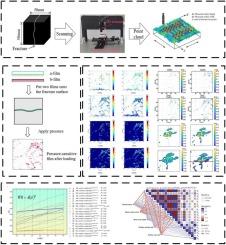Micro-scale shale fracture wear under normal stress: 3D point cloud-coupled experiments/simulations study
IF 7.9
2区 材料科学
Q1 MATERIALS SCIENCE, MULTIDISCIPLINARY
引用次数: 0
Abstract
A comprehensive understanding of frictional interactions and wear mechanisms in rough fractures is critical for advancing research in earthquake dynamics and associated geological hazards. Systematic loading experiments were performed on unconfined shale fractures using a six-dimensional rock pressure detection and displacement monitoring system. High-resolution three-dimensional point cloud datasets of fracture surfaces were acquired via laser profilometry, while pressure-sensitive films were employed to quantitatively map contact behavior under varying normal stresses. Spatial integration of point cloud data with pressure-sensitive film measurements demonstrated that initial contact occurs preferentially at asperities with elevated heights. A wear distribution model was constructed by computationally aligning and subtracting pre- and post-loading topographic datasets. Mesh-based analytical methods identified a robust correspondence between extreme wear loci and regions of concentrated contact stress. The steady-state wear rate of shale fractures followed a power-law relationship with normal stress, consistent with micromechanical wear theories. Statistical evaluation of 3D surface topography parameters revealed that the root-mean-square height (Sq) displayed significant correlations (Pearson’s r > 0.85, p < 0.01) with mechanical metrics. These findings advocate for Sq as a robust 3D geomechanical index for characterizing contact wear evolution in fractured media.

正应力下微尺度页岩破裂磨损:三维点云耦合实验/模拟研究
全面了解粗糙裂缝中的摩擦相互作用和磨损机制对于推进地震动力学和相关地质灾害的研究至关重要。采用六维岩石压力检测与位移监测系统对无侧限页岩裂缝进行了系统加载试验。通过激光轮廓测量获得了高分辨率的断裂面三维点云数据集,而压敏薄膜则用于定量绘制不同法向应力下的接触行为。点云数据与压敏薄膜测量的空间整合表明,初始接触优先发生在高度较高的凸起处。通过对加载前后的地形数据集进行计算对齐和相减,构建了磨损分布模型。基于网格的分析方法确定了极端磨损位点与集中接触应力区域之间的强大对应关系。页岩裂缝的稳态磨损率与正应力呈幂律关系,与微机械磨损理论一致。对三维表面形貌参数的统计评估显示,均方根高度(Sq)与力学指标具有显著相关性(Pearson’s r > 0.85, p < 0.01)。这些发现表明Sq是表征断裂介质中接触磨损演变的可靠三维地质力学指标。
本文章由计算机程序翻译,如有差异,请以英文原文为准。
求助全文
约1分钟内获得全文
求助全文
来源期刊

Materials & Design
Engineering-Mechanical Engineering
CiteScore
14.30
自引率
7.10%
发文量
1028
审稿时长
85 days
期刊介绍:
Materials and Design is a multi-disciplinary journal that publishes original research reports, review articles, and express communications. The journal focuses on studying the structure and properties of inorganic and organic materials, advancements in synthesis, processing, characterization, and testing, the design of materials and engineering systems, and their applications in technology. It aims to bring together various aspects of materials science, engineering, physics, and chemistry.
The journal explores themes ranging from materials to design and aims to reveal the connections between natural and artificial materials, as well as experiment and modeling. Manuscripts submitted to Materials and Design should contain elements of discovery and surprise, as they often contribute new insights into the architecture and function of matter.
 求助内容:
求助内容: 应助结果提醒方式:
应助结果提醒方式:


